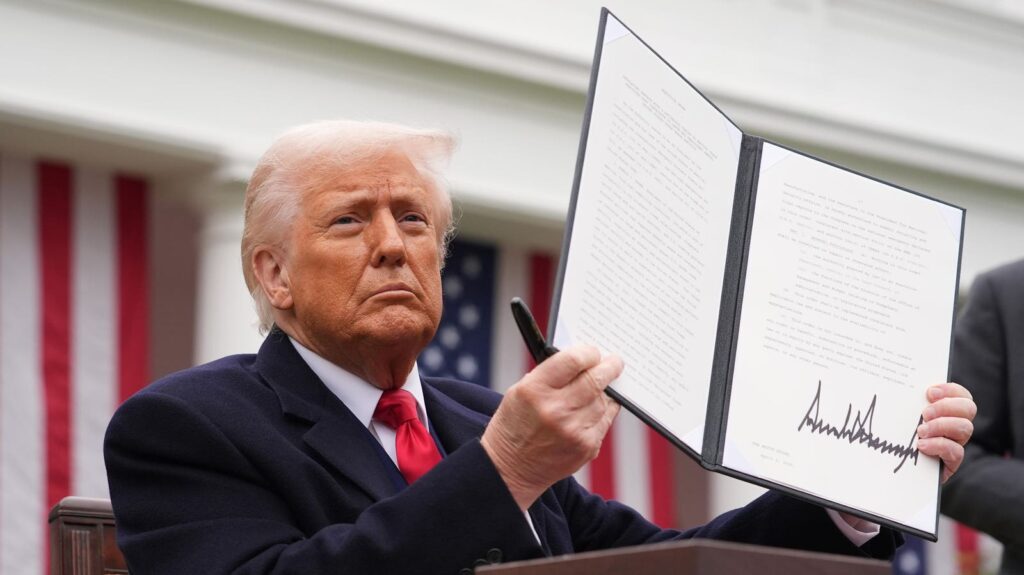Topline
President Donald Trump’s “Liberation Day” tariffs will remain in effect for now despite Wednesday’s ruling declaring them unlawful, as a federal appeals court ruled Thursday that the tariffs can stay while it deliberates on the case—though they still could be struck down later.
President Donald Trump displays a signed executive order imposing tariffs on April 2 in Washington, … More
Key Facts
The U.S. Court of Appeals for the Federal Circuit paused a lower court’s order that declared Trump’s tariffs to be unlawful, meaning the tariffs will remain in effect while the appeals court decides whether or not to uphold the Court of International Trade’s ruling.
That means Trump’s “Liberation Day” tariffs will remain in place until at least June 9, based on the dates the court gave for the Trump administration and plaintiffs in the case to submit court filings over whether the appeals court should issue a lengthier order keeping the tariffs in effect.
The Trump administration asked for the tariffs to stay in effect while they appeal Wednesday’s ruling, in which the Court of International Trade struck down Trump’s sweeping April 2 tariffs as being unlawful because the president didn’t have authority to impose sweeping tariffs under the law he used to justify them.
While the tariffs are in effect for now, if an appeals court or the Supreme Court ultimately sides with the Court of International Trade and says they’re unlawful, the Trump administration will have to refund any tariffs that it collects.
Jeffrey Schwab, a lawyer at the Liberty Justice Center who represented businesses suing the Trump administration, said Thursday the appeals court’s ruling is “merely a procedural step,” and the plaintiffs are “confident” that after all the court briefs are submitted by June 9, “the Federal Circuit will ultimately deny the government’s motion [to keep the tariffs in effect] shortly thereafter, recognizing the irreparable harm these tariffs inflict on our clients.”
What To Watch For
The Federal Circuit could still ultimately decide Trump’s tariffs are unlawful and should be struck down—or halted while the litigation moves forward—despite them siding with the president in Thursday’s ruling. The dispute over the tariffs’ legality is ultimately expected to play out at the Supreme Court, though it’s unclear when and how justices could rule on the issue. Attorneys for the businesses that sued Trump in the Court of International Trade—one of two lawsuits at the heart of Wednesday and Thursday’s rulings—told reporters Thursday they were “guardedly optimistic” about their chances of winning before the appeals court, given how strongly the Court of International Trade ruled in favor of their position.
Tangent
The Federal Circuit’s decision was one of two rulings that came out Thursday on Trump’s tariffs, as a federal district judge in Washington, D.C., also declared the president’s “Liberation Day” tariffs unlawful in a separate lawsuit. The order in that case only applied to the specific businesses that brought the lawsuit, so even though the Federal Circuit has now put Trump’s tariffs back in effect, those companies will not be subject to the tariffs. The district court’s ruling will not stop the Trump administration from levying tariffs on any other imported goods.
What Happens Next With Trump’s Tariffs?
White House Press Secretary Karoline Leavitt told reporters Thursday the Trump administration is pushing ahead with its tariff agenda, despite the Court of International Trade’s ruling upending them. Leavitt said before the appeals court’s ruling that Trump officials are still holding trade negotiations with other countries to determine the final tariff rates the U.S. will impose on their imports, as the White House believes the Supreme Court or appeals court will ultimately uphold the “Liberation Day” tariffs. The press secretary did not rule out that Trump could try to impose new additional tariffs under other laws, however, which give presidents more explicit power to levy tariffs, but aren’t as expansive or as easy to implement as the existing tariffs. “We can walk and chew gum at the same time,” Leavitt said when asked if the administration would try to implement new tariffs right away, or just focus on its existing legal battle first.
Key Background
Trump imposed his sweeping “Liberation Day” tariffs on nearly all countries on April 2, fulfilling a longtime campaign promise of near-universal tariffs despite warnings from economists that doing so could harm the economy. The president used the International Emergency Economic Powers Act (IEEPA) to justify the tariffs, which gives presidents broad authority to impose economic sanctions during national emergencies. Plaintiffs, including businesses and Democratic-led states, have challenged that in court, arguing IEEPA does not say anything about tariffs or give Trump broad power to impose them—and that even if it did, just having trade imbalances with other countries does not constitute an “emergency” that allows Trump to invoke the law. A three-judge panel at the Court of International Trade agreed, ruling Wednesday that Trump does not have the authority to impose sweeping tariffs under IEEPA and “any interpretation of IEEPA that delegates unlimited tariff authority is unconstitutional.” The panel included judges appointed by presidents of both parties, including a Trump appointee. The Trump administration appealed the court’s decision almost immediately after it was issued and asked the appeals court to issue “immediate” relief, teeing up Thursday’s order.
Further Reading
Read the full article here
